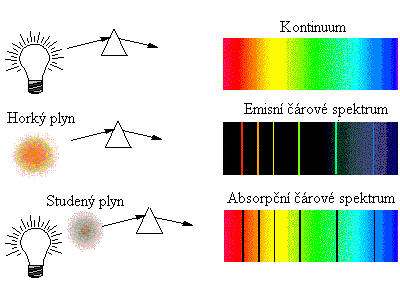Spectra
Introduction
Nowadays astrophysics and modern scientific laboratories rely on quality spectrometer, which provides spectral (or frequency) analysis. From spectra we can obtaian information about individual frequencies and their representation, from which we can get e.g. chemical composition of space objects, motion of source and so on, depending on the field.

Spectral lines, whose origin was mysterious for a long time, are key for spectral analysis. They were explained with quantum hypothesis and energy conservation law.
The quantum hypothesis the light isn't emitted continuously, but discretly in quantums of energy called photons. Energy Ef of each photon depends only on its frequency f
Ef = hf
where h = 6,63·10−34 J·s is Planck constant. Quantum physics states that electrons in atom orbitals can't have arbitrary energy and their energy states are discrete, they can be found in these states. The electrons can change to another energy state, but the conservation of energy must hold, so it requires to create and emit photon (emission) with exactly defined energy, or such photon with exact energy must be absorbed. Let's denote two allowed energy states E1 and E2 (E2>E1), then the conservation law of energy states

|
Ef = ΔE = E3 − E2 = hf |
Kirchhoff laws of spectral analysis states, when the absorbtion and emission occurs.
- Red-hot object (e.g. star, bulb fiber) at certain temperature T emits all frequencies, which is observed as continuum in the spectrum.
- Hot gas (in space e.g. cloud of hot hydrogen) emits only some wavelengths (allowed frequencies), which we observe as bright emision lines on dark background.
- Cold gas (in space e.g. cloud of hydrogen at temeprature T1 between Earth and distant star at temeprature T>T1) absorbs exact wavelengths from continuum (responding frequencies), so there are absorb lines in the spectrum.

The easiest and most widespread element in the universe - the hydrogen (system containing one proton and electron) - has observable spectral lines that are easily described with one equation. In remote laboratory you have possibility to measure spectral lines from spectrum and then conclude some expression (heurestic approach) or you can theoretically derive that equation and then verify it (verification approach). Vyberte si.
Heurestic approach is recomended to people deeper interested in physics.
Visit remote laboratory on UK MFF, read instructions and follow tasks for secondary school students.
Verification approach – verification of validity Ritz-Rydberg combination principle and Rydberg formulae
Study the theory.
Read the instructions and do the remote measurement.
